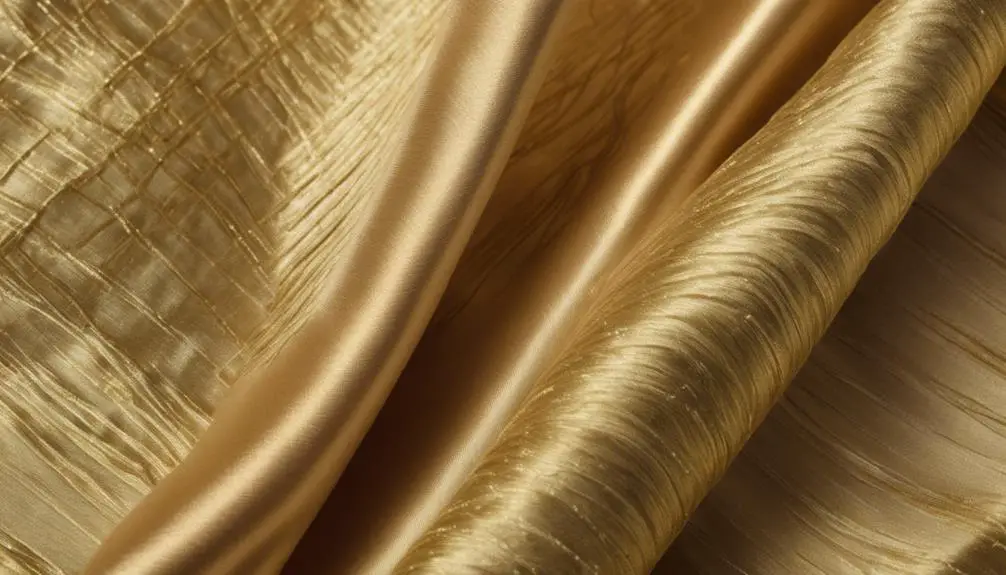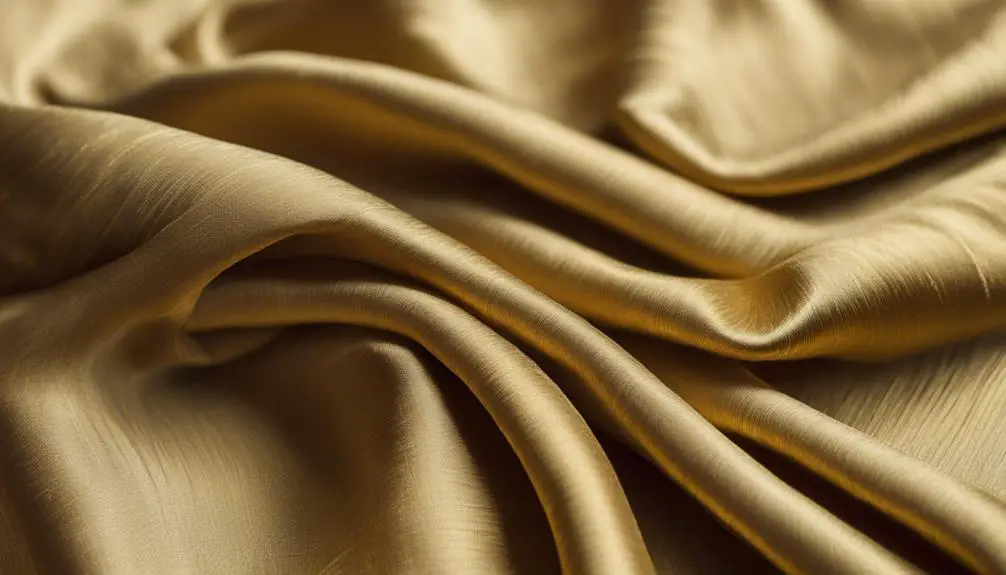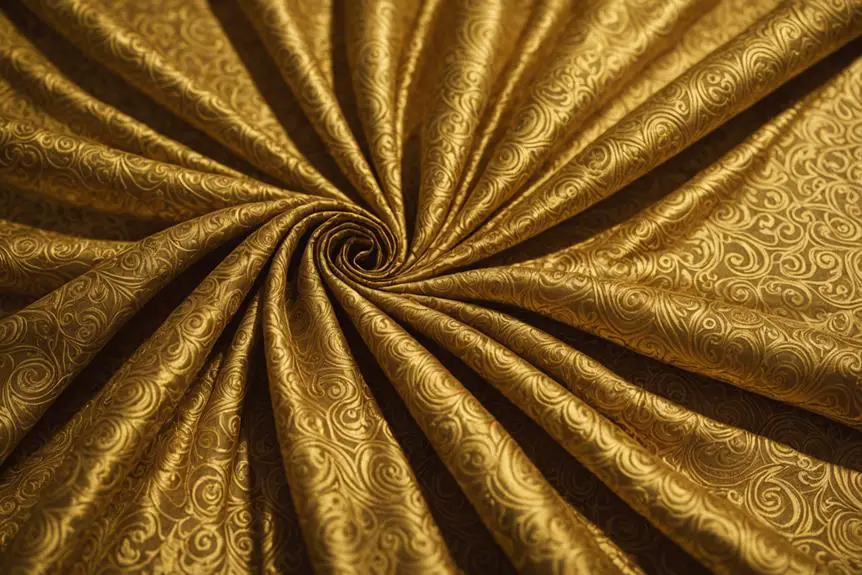When you're trying to identify Muga silk fabric, it is crucial to start with the visual cues that set it apart from other silks. Notice the unique golden sheen that varies from deep gold to light brown, and pay attention to the texture; any irregularities can indicate handcrafted quality. You'll also want to assess the weight, as genuine Muga silk tends to be heavier than its counterparts. But that's just the beginning—there are more techniques and tests that can solidify your understanding of this luxurious fabric. What's the next step you should take?
Unique Characteristics of Muga Silk

Muga silk stands out for its unique characteristics that make it truly special among textiles. Have you ever seen a fabric with a unique golden sheen that instantly catches your eye? That's Muga silk for you! Originating from Assam, this premium textile is highly sought after because of its stunning appearance and rare qualities. Unlike other silks, Muga silk is durable and resistant to sunlight, meaning it won't fade as quickly as some of its counterparts. You'll appreciate how it lasts longer, making it a great investment for your wardrobe.
Now, let's talk about the texture. Muga silk has a rigid texture, giving it a distinctive feel and drape. If you're used to the soft and smooth touch of mulberry silk, you'll notice the difference right away. It's not just about comfort; it's about style! Plus, did you know that producing Muga silk requires over 1,000 cocoons to yield just 125 grams of silk fibers? That's pretty rare, right? This rarity adds to its high value and makes it a true treasure.
Muga silk is also recognized under the Geographical Indicator (GI) list of India, which highlights its authenticity and cultural significance. So, when you choose Muga silk, you're not just picking a fabric; you're embracing a piece of Assam's rich heritage. Don't you want to wear something that tells such a beautiful story?
Visual Inspection Techniques
When you're examining Muga silk, the visual inspection techniques you employ can make all the difference. First things first, check out that unique golden sheen! Genuine Muga silk shines like no other, showing off colors from deep gold to light brown. It's like holding a piece of the sun!
Next, look for irregularities in the fabric. Handwoven Muga silk often has slight variations in texture and pattern, which is a sign of artisanal craftsmanship. If it looks too perfect, it might not be the real deal. You want that authentic charm that only comes from skilled hands in Assam, where this silk is made.
Don't forget about the weightiness! Muga silk has a distinct heft that makes it drape beautifully. If it feels flimsy or overly smooth, you might be dealing with a synthetic alternative. And hey, keep an eye out for the Geographical Indication (GI) tag. This little badge of honor indicates that your silk is genuinely from Assam and meets quality standards.
Touch and Texture Analysis

In your quest to identify Muga silk, touch and texture analysis plays an essential role. You'll quickly notice that Muga silk has a unique, slightly coarse texture. Unlike the soft, smooth feel of Mulberry silk, Muga silk feels more rigid. This distinctive touch is your first clue!
When you handle Muga silk, pay attention to its natural golden sheen. It's not just for looks; this subtle luster catches light in a way that's simply mesmerizing. You'll feel the difference!
Here are some feelings you might experience while touching Muga silk:
- A sense of luxury that whispers of royal patronage.
- A sturdy confidence in its durability, knowing it won't wear out easily.
- A delight in its weight, making it feel like a true treasure.
As you explore the fabric, notice how Muga silk has a slightly waxy feel. This texture indicates its durability, setting it apart from smoother silk fabrics like Eri silk. You might also find that Muga silk feels heavier than other silks, giving it a substantial presence when draped. Plus, it doesn't slip off surfaces easily, thanks to its slight grip!
Burning Test for Authenticity
To confirm the authenticity of Muga silk, you can perform a burning test, which reveals key characteristics of this unique fabric. First, take a small sample of the silk—don't worry, you won't need a whole yard! When you hold it to a flame, pay attention. Genuine Muga silk will burn slowly, curling up and leaving behind a dark ash residue that looks a lot like burnt hair. Yep, you heard that right!
Now, here's where it gets interesting. As it burns, Muga silk releases a distinct protein odor—think of it as the natural fibers' way of saying, "Hey, I'm the real deal!" In contrast, synthetic fabrics will usually give off a chemical smell, and we definitely don't want that. If your fabric is authentic, it won't have a bright flame; instead, it'll smolder and might take a little time to ignite.
Also, keep in mind that unlike synthetic fibers, which love to melt and fuse together when things heat up, Muga silk will turn to ash and leave no residue behind. Pretty cool, right? Just remember, while the burn test is a reliable method for identifying Muga silk, you should be careful to avoid damaging your fabric. So, are you ready to become a Muga silk expert? Grab that sample and let's find out if it's the genuine article!
Historical Context and Significance

Tracing back to ancient civilizations, Muga silk holds a rich historical significance that's integral to Assam's cultural heritage. Did you know that its roots can be traced to the Indus Valley Civilization, around 2400-2500 BCE? That's a long time ago! The reference to silk in ancient texts like the Vedas, Mahabharata, and Ramayana shows just how much this fabric meant to ancient Indian society.
The Ahom dynasty, which ruled Assam for nearly 600 years, took Muga silk to another level. They established a dedicated department for silk weaving, supporting skilled artisans. Imagine a whole kingdom backing you up to create beautiful fabric!
Here are some heartwarming thoughts about Muga silk:
- A symbol of Assamese pride, representing centuries of tradition.
- A connection to our past, reminding us of the artistry of ancient weavers.
- A bridge to the world, linking Assam to trade networks as far as China!
Muga silk's trade connections date back to around 100 BCE, showing its significance in historical commerce. So, when you wear or admire Muga silk, you're not just appreciating fabric; you're celebrating a rich tapestry of history, culture, and art. Isn't that amazing? It's not just silk; it's a story woven through time!
Frequently Asked Questions
What Are the Characteristics of Muga Silk?
Muga silk's got some amazing characteristics! Its natural sheen shines in golden hues, making it unique and eye-catching. You'll love its durability traits, too; it resists sunlight better than other silks! The texture differences give it a bit of a rigid feel, unlike the soft mulberry silk. Plus, the color variations depend on what the larvae munch on! With rich regional origins and historical significance, it's a true treasure to care for!
What Is the Difference Between Silk and Muga Silk?
So, what's the difference between silk and Muga silk? Well, Muga silk's got this amazing golden sheen that regular silk just doesn't have! Plus, it's tougher and more durable, which is awesome for long-lasting pieces. The Muga silk production process is unique, and the artisans in Assam have been perfecting it for ages. Plus, with its sustainability and cultural significance, Muga silk's not just pretty; it's a treasure you can wear! Isn't that cool?
How Can You Tell What Kind of Silk You Have?
You can tell what kind of silk you've got by checking its texture and sheen. Different silk types feel and look unique. If it's stiff or has a waxy feel, it might be Muga! Look for natural colors, not bright dyes—those are usually signs of synthetic stuff. Also, consider the fabric care and maintenance tips; real silk often needs gentler washing. Don't forget to explore its historical significance and regional varieties for a fun twist!
How to Recognize Silk Fabric?
Recognizing silk fabric can be super fun! You'll want to feel the texture—silk's often smooth, but some types, like Muga, might feel a bit coarser. Check the shine too; it's a big deal in silk history! Look at how it drapes; heavier silks have a more structured look. And don't forget about silk care; gentle washing keeps it vibrant. Isn't it cool how silk weaving and dyeing create such unique styles in fashion?
Conclusion
So, there you have it! Identifying Muga silk is all about spotting that gorgeous golden sheen, checking the weight, and feeling the texture. Plus, don't forget that burning test—it's a real game changer! With these tips, you'll be on your way to becoming a Muga silk expert in no time. Isn't it cool to know you can impress your friends with your newfound knowledge? Go ahead, give it a try, and enjoy the luxurious feel of authentic Muga silk!




